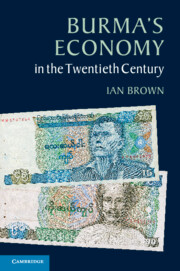Book contents
- Frontmatter
- Dedication
- Contents
- List of Illustrations
- List of Tables
- Note on names
- Acknowledgements
- Map of Burma/Myanmar
- Introduction
- 1 The economy at the beginning of the twentieth century
- 2 Strains in the late colonial economy
- 3 War and independence
- 4 In pursuit of socialism
- 5 Toward the market: the economy from 1988
- Conclusion: themes and threads
- Bibliography
- Index
- References
1 - The economy at the beginning of the twentieth century
Published online by Cambridge University Press: 05 June 2014
- Frontmatter
- Dedication
- Contents
- List of Illustrations
- List of Tables
- Note on names
- Acknowledgements
- Map of Burma/Myanmar
- Introduction
- 1 The economy at the beginning of the twentieth century
- 2 Strains in the late colonial economy
- 3 War and independence
- 4 In pursuit of socialism
- 5 Toward the market: the economy from 1988
- Conclusion: themes and threads
- Bibliography
- Index
- References
Summary
A jewel in the imperial diadem
In the preface to a ‘comprehensive treatise’ on Burma published in 1901, a former British official declared the territory to be ‘one of the richest provinces of our Indian Empire’, adding on a later page, rather more poetically, ‘one of the brightest jewels in the Imperial diadem of India’. There was much to sustain that view. To judge by the near-relentlessly rising production and trade statistics, the vast rural expanses under commercial cultivation, and the crowded wharves and hectic commercial streets of the capital, Rangoon, Burma at the beginning of the twentieth century was indeed a prosperous possession, a notably valuable component in Britain's eastern empire.
Colonial Burma's economic position was built mainly on the cultivation and export of rice. In the first decade of the twentieth century, Burma exported on average 2.17 million tons of rice and paddy (rice grain still in the husk) each year, making it by some distance the single most important rice-exporting country in the world. Just over one-third of those exports was sold in Europe, partly for use as food and fodder, in brewing, and in the manufacture of starch, but also for re-export, after re-milling, to Cuba, the West Indies, West Africa, and South America. A further quarter or more was shipped to India and Ceylon, for India, prone to scarcity and famine, had long regarded Burma as a granary from which any large or unexpected demand could at once be supplied. The final substantial markets for Burma's rice in the first decade of the twentieth century were China and Japan and, more importantly, South East Asia. Rice shipped to South East Asia – Singapore was an important initial destination – fed the populations of immigrant Chinese and Indians in the Malay States, Straits Settlements, and the Netherlands East Indies engaged in the production, processing, and shipping of those territories’ principal commodity exports, tin, tobacco, sugar, and rubber.
- Type
- Chapter
- Information
- Burma's Economy in the Twentieth Century , pp. 6 - 43Publisher: Cambridge University PressPrint publication year: 2013



